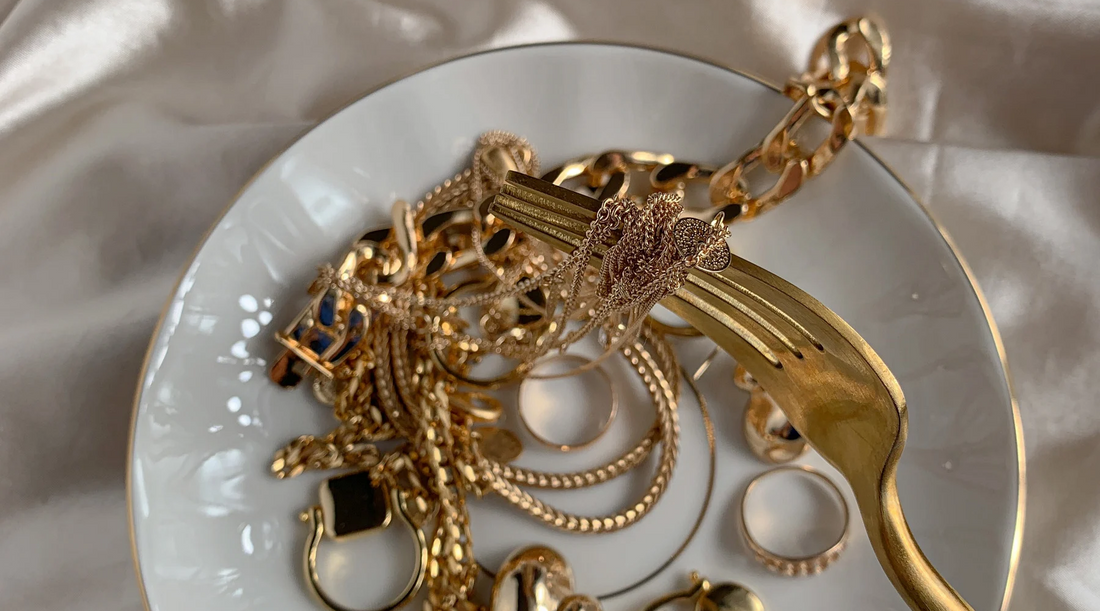
SOLID GOLD VS. GOLD-PLATED JEWELRY: What's The Difference & Which One Should You Buy?
Gold jewelry is a timeless symbol of elegance, but not all gold jewelry is the same. Today, with rising gold prices and a growing interest in affordable luxury, buyers are increasingly comparing solid gold vs. gold-plated jewelry. Whether you're looking for an investment piece or trendy, budget-friendly accessories, knowing the differences is essential.
In this guide, we’ll break down the key differences, pros and cons, how to identify quality gold jewelry, which option suits your needs best and finally, how to care for solid gold & gold-plated jewelry. Let's dive in!
What Is Solid Gold Jewelry?
Solid gold jewelry is made from a gold alloy that consists of pure gold mixed with other metals like copper, silver, or zinc for durability. Gold is a soft metal, so these alloys strengthen it.
Understanding Karats in Solid Gold
Gold purity is measured in karats (K):
- 24K (99.9% pure gold) – Soft, bright yellow, rarely used for jewelry.
- 18K (75% gold, 25% alloy metals) – High-quality, durable, and retains value.
- 14K (58.3% gold, 41.7% alloy metals) – Most common for everyday jewelry.
- 10K (41.7% gold, 58.3% alloy metals) – More affordable, durable but less vibrant in color.
What Is Gold-Plated Jewelry?
Gold-plated jewelry has a base metal (such as brass, copper, or stainless steel) coated with a thin layer of gold through electroplating. The thickness of the gold layer varies but is typically 0.5 to 2.5 microns.
Different Types of Gold-Plated Jewelry
- Gold Plated (GP): A very thin gold layer, prone to fading.
- Gold Vermeil: Uses sterling silver as the base metal with a thicker gold coating (usually 2.5 microns).
- Gold-Filled: A thick bonded layer of gold, more durable than regular gold plating.
Pros & Cons of Solid Gold Jewelry

Pros & Cons of Gold-Plated Jewelry

How to Tell the Difference Between Solid Gold and Gold-Plated Jewelry
1. Hallmarks & Stamps:
- Solid gold jewelry is stamped with purity marks like “18K,” “14K,” or “10K.”
- Gold-plated jewelry may have markings like “GP,” “GEP” (gold electroplated), or “HGE” (heavy gold electroplate).
2. Magnet Test:
- Solid gold is not magnetic, but gold-plated jewelry with a metal core may attract a magnet.
3. Scratch Test:
- Solid gold is softer and may show small dents over time.
- Gold-plated jewelry may reveal a different base metal underneath if scratched.
4. Water & Tarnish Test:
- Solid gold won’t tarnish, even in water.
- Gold-plated jewelry may show discoloration or fade over time, especially when exposed to moisture.
Which One Should You Buy?
Choose Solid Gold If:
✔ You want a long-term investment.
✔ You have sensitive skin and need hypoallergenic jewelry.
✔ You prefer durability and jewelry that won’t fade or tarnish.
Choose Gold-Plated Jewelry If:
✔ You love trendy pieces but don’t want to spend a fortune.
✔ You like having a variety of jewelry without a huge investment.
✔ You don’t wear the same piece every day and can maintain it properly.
Caring for Gold Jewelry: Maintenance Tips
How to Maintain Solid Gold Jewelry:
- Clean with warm water and mild soap.
- Store in a fabric-lined jewelry box to prevent scratches.
- Avoid exposure to harsh chemicals like chlorine.
How to Maintain Gold-Plated Jewelry:
- Avoid water, sweat, and perfume exposure.
- Wipe gently with a soft cloth after each use.
- Store in an airtight pouch to prevent oxidation.
Both solid gold and gold-plated jewelry have their unique advantages. If you’re looking for luxury, durability, and investment value, go for solid gold. If you love affordable trends and fashion flexibility, gold-plated jewelry is a fantastic choice.
It is also worth noting that as jewelry trends continue to lean towards sustainable luxury, consider more earth-friendly gold vermeil or gold-filled options like this 18K Yellow Gold Pendant Necklace by JACOBSVOW for a balance between quality and affordability.
Are you a solid gold or gold-plated kind of jewelry lover? Let us know in the comments!
